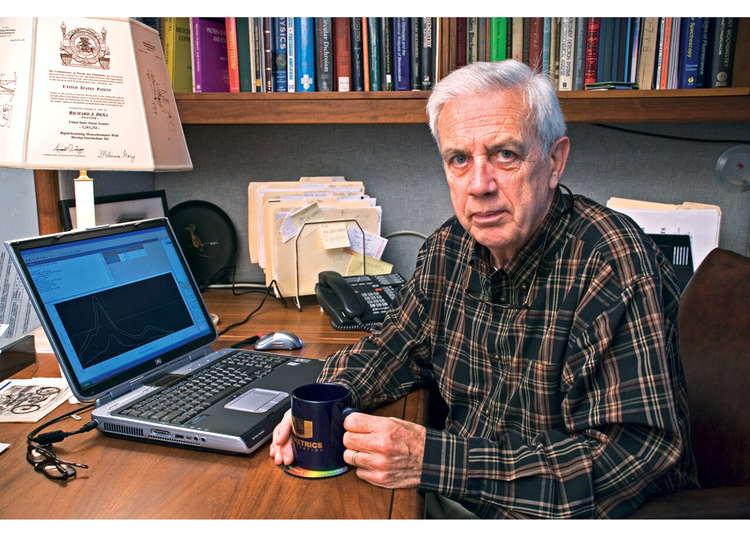The Main Principles Of Circular Dichroism
The Main Principles Of Circular Dichroism
Blog Article
Getting My Uv/vis/nir To Work
Table of ContentsA Biased View of Circular DichroismThe 10-Second Trick For SpectrophotometersNot known Factual Statements About Uv/vis The Main Principles Of Uv/vis/nir The Ultimate Guide To Uv/vis/nir

Spectrophotometry is a tool that hinges on the quantitative analysis of molecules depending on how much light is taken in by colored substances.
What Does Uv/vis Mean?
A spectrophotometer is typically used for the measurement of transmittance or reflectance of solutions, transparent or nontransparent solids, such as sleek glass, or gases. Although many biochemicals are colored, as in, they take in noticeable light and therefore can be measured by colorimetric procedures, even colorless biochemicals can frequently be converted to colored compounds ideal for chromogenic color-forming reactions to yield substances appropriate for colorimetric analysis.: 65 However, they can also be designed to measure the diffusivity on any of the noted light ranges that normally cover around 2002500 nm utilizing different controls and calibrations.
An example of an experiment in which spectrophotometry is utilized is the determination of the stability constant of a service. A specific chain reaction within an option might happen in a forward and reverse direction, where reactants form products and products break down into reactants. Eventually, this chain reaction will reach a point of balance called an equilibrium point.
The Basic Principles Of Uv/vis/nir
The amount of light that passes through the solution is indicative of the concentration of specific chemicals that do not permit light to go through. The absorption of light is because of the interaction of light with the electronic and vibrational modes of particles. Each kind of particle has a private set of energy levels associated with the makeup of its chemical bonds and nuclei and hence will absorb light of specific wavelengths, or energies, resulting in special spectral homes.
They are widely used in many markets consisting of semiconductors, laser and optical production, printing and forensic examination, as well as in labs for the study of chemical compounds. Spectrophotometry is often utilized in measurements of enzyme activities, determinations of protein concentrations, decisions of enzymatic kinetic constants, and measurements of ligand binding reactions.: 65 Ultimately, a spectrophotometer is able to determine, depending on the control or calibration, what compounds are present in a target and exactly how much through computations of observed wavelengths.
Invented by Arnold O. Beckman in 1940 [], the spectrophotometer was produced with the help of his coworkers at his business National Technical Laboratories founded in 1935 which would end up being Beckman Instrument Business and ultimately Beckman Coulter. This would come as a solution to the formerly developed spectrophotometers which were not able to absorb the ultraviolet correctly.
Some Known Questions About Uv/vis/nir.
It would be found that this did not provide acceptable outcomes, for that reason in Design B, there was a shift from a glass to a quartz prism which enabled for better absorbance results - UV/Vis (https://www.slideshare.net/julieanndesalorenz30). From there, Model C was born with a change to the wavelength resolution which wound up having 3 systems of it produced
It was produced from 1941 to 1976 where the cost for it in 1941 was US$723 (far-UV accessories were an alternative at extra cost). In the words of Nobel chemistry laureate Bruce Merrifield, it was "probably the most essential instrument ever developed towards the development of bioscience." Once it ended up being stopped in 1976, Hewlett-Packard developed the very first commercially available diode-array spectrophotometer in 1979 understood as the HP 8450A. It irradiates the sample with polychromatic light which the sample takes in depending upon its properties. Then it is transmitted back by grating the photodiode variety which discovers the wavelength area of the spectrum. Given that then, the creation and application of spectrophotometry devices has actually increased tremendously and has actually turned into one of the most ingenious instruments of our time.

What Does Spectrophotometers Do?
The grating can either be movable or repaired.
In such systems, the grating is repaired and the strength of each wavelength of visit site light is measured by a various detector in the variety. In addition, most modern-day mid-infrared spectrophotometers utilize a Fourier transform method to get the spectral details - https://www.blogtalkradio.com/olisclarity1. This technique is called Fourier transform infrared spectroscopy. When making transmission measurements, the spectrophotometer quantitatively compares the portion of light that travels through a recommendation option and a test service, then digitally compares the strengths of the two signals and computes the portion of transmission of the sample compared to the reference requirement.

Report this page